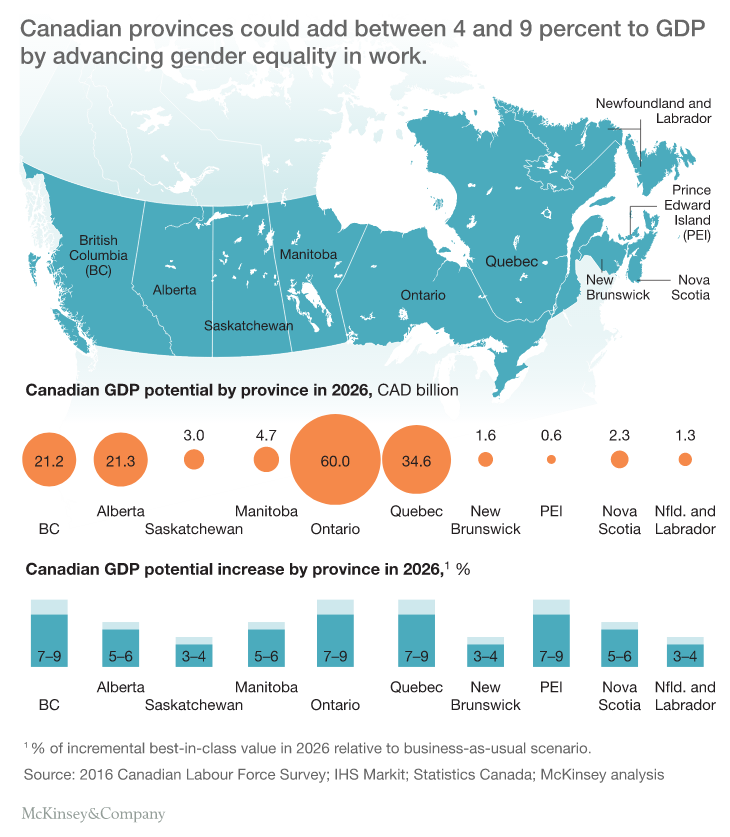Helping women achieve equal opportunities in the workplace could add $150 billion to Canada’s GDP by 2026, according to a new report.

Canada doesn’t fare too badly, in terms of gender equality, when compared to other countries, but forward momentum has stalled for the past 20 years, said McKinsey Global Institute (MGI), the business and economics research arm of international consultancy McKinsey & Company.
READ MORE: Here’s what Canadian women would be making in these jobs if they were men
Public and corporate policies that push the accelerator pedal on progress again could help the country add 0.6 per cent to annual GDP growth, MGI said.
That may not sound like much, but when it comes to GDP, it’s a significant increase. Canada has been growing by an average of 2 per cent a year for the past 10 years or so, compared with 3 to 4 per cent over the previous decade. The slowdown is largely the product of the country’s aging workforce, according to economists.
But getting more women to work, work longer hours and work in sectors with higher productivity rates would help the economy find its mojo again, the report suggests. The combined effect of all that would be the equivalent of adding a whole new financial sector to the economy, the authors of the report calculated.
READ MORE: In an aging Canada, women need to save more than men — even if they make less
Every province in Canada would gain between 4 and 9 per cent in GDP growth over the next decade.
Women’s labour force participation rate as been decreasing

Get weekly money news
Women’s involvement in the labour force surged between the mid-1950s and 1990 but then slowed down markedly, plateaued, and then started dipping, according to Statistics Canada. That trend is expected to continue unless demographic trends change. Raising women’s participation rate from 61 to 64 per cent would get Canada 42 per cent of the way to achieving the $150-billion boost by 2026.
READ MORE: Single women play down their ambition to attract men, new study finds
More women managers, scientists and entrepreneurs
Canada also needs to have more women in high-productivity jobs. Female workers currently make up only 35 per cent of managerial positions, 23 per cent of science, technology, engineering, and mathematics (STEM) workers, and 20 per cent of small business owners.
Notably, positions in management and natural and applied sciences were the top two most highly paid positions in a recent StatsCan survey of average hourly pay in Canada.
But climbing the corporate ladder continues to be a challenge for women. Female employees are less likely than men to advance at almost every step in their careers, the report found, with promotion from director to vice president “a particular bottleneck,” where men are three times more likely than women to move up.
READ MORE: More Canadian families have female breadwinners, but it still creates tensions
“The loss of female talent along the pipeline is not due to lack of ambition or higher attrition — women aspire to promotions at a similar rate and actually leave at a lower rate than their male counterparts,” reads the report.
Mining and utilities are another two high-productivity industries where Canada could use more women.
“Emerging technologies such as GPS surveying, automated loading and transportation, and robotics are not only increasing productivity in these sectors, but also creating opportunities to involve more women,” said the report.
Adding women to key sectors of the economy would contribute another 42 per cent to the $150-billion target, according to McKinsey.
Enabling women to work 50 hours a week
Making is easier for women to work longer hours would also help Canada pump its growth rate.
READ MORE: The genius life hacks that working moms and dads use to get it all done
Canadian women work 32.8 hours per week, compared to 38.5 hours for men. That’s mostly because female workers are more likely to opt for the flexibility of part-time jobs. In 2016, they made up 66 per cent of part-time employees in Canada.
Lengthening women’s average work week by just 50 minutes would add $24 billion to the economy in 2026, the report said.









Comments